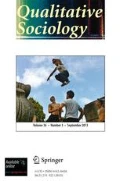Abstract
Recent years have seen fundamental shifts in the objectives and delivery of assistance to the homeless. An early emphasis on emergency shelter and monetary housing assistance has been replaced by a focus on programs designed to blend shelter with an array of social services. In most instances, however, programs combining shelter and social services are designed as transitional; that is, they are intended to help homeless individuals and families move from a position of dependence to one where they can live “independently.” The emphasis in transitional housing programs is on making homeless people “housing ready.” This paper concerns the process of assessing “housing readiness” as observed during eighteen months of fieldwork in a federally supported transitional housing program for formerly homeless single adults. The detailed case study that follows supports three important findings. First, there was virtual unanimity among staff and residents that substance abuse was the cause of their homelessness and the key to its solution. Second, success within the program was defined and operationalized along very specific but well understood normative dimensions that have little to do with the material circumstances in which residents find themselves and everything to do with “recovery.” Third, “recovery”—the key to housing readiness in this environment—was measured not by objective measures, i.e., number of months sober, but rather by what was widely referred to as one's “quality of sobriety,” a subjective and consequently often hotly debated measure of attitude and outlook only loosely related to demonstrable abstinence from alcohol. This last finding, that ultimately housing readiness is a subjective judgment, both increases the discretion of shelter staff and generates a systematic disattention to the individual economic issues that are fundamental to an exit from homelessness.
Similar content being viewed by others
REFERENCES
Annis, H. M., & Davis, C. S. (1989). Relapse prevention. In R. K. Hester & W. R. Miller (Eds.), Handbook of alcoholism treatment approaches: Effective alternatives (pp. 170-182). New York: Pergamon Press.
Baum, A. S., & Burnes, D. W. (1993). A nation in denial: The truth about homelessness. Boulder, CO: Westview Press.
Dordick, G. A. (1997). Something left to lose: Personal relations and survival among New York's homeless. Philadelphia: Temple University Press.
Dordick, G. A. (unpublished manuscript). The new architecture of dependency: Local knowledge and the construction of a homeless housing market.
Edin, K., & Lein, L. (1997). Making ends meet: How single mothers survive welfare and low-wage work. New York: Russell Sage Foundation.
Fischer, P. L., & Breakey, W. R. (1991). The epidemiology of alcohol, drug, and mental disorders among homeless persons. American Psychologist, 46, 1115-1128.
Gerstel, N., Bogard, C. J., McConnell, J. J., & Schwartz, M. (1996). The therapeutic incarceration of homeless families. Social Service Review, 70, 543-572.
Gray, M. (1993). Relapse prevention. In S. L. A. Straussner (Ed.), Clinical work with substance-abusing clients (pp. 351-368). New York: The Guilford Press.
Jencks, C. (1994). The homeless. Cambridge: Harvard University Press.
Marcuse, P. (1990). Homelessness and housing policy. In C. M. L. Caton (Ed.), Homeless in America (pp. 139-159). New York: Oxford University Press.
O'Flaherty, B. (1996). Making room: The economics of homelessness. Cambridge: Harvard University Press.
Piliavin, I., Wright, B. R. E., Mare, R. D., & Westerfelt, A. H. (1996). Exits from and returns to homelessness. Social Service Review, 70, 33-37.
Rossi, P. H. (1989). Down and out in America: The origins of homelessness. Chicago: University of Chicago Press.
Snow, D., & Anderson, L. (1993). Down on their luck: A study of homeless street people. Berkeley and Los Angeles: University of California Press.
Snow, D., Baker, S. G., Anderson, L., & Martin, M. (1986). The myth of pervasive mental illness among the homeless. Social Problems, 33, 407-423.
Stack, C. B. (1974). All our kin: Strategies for survival in a black community. New York: Harper and Row.
Stone, M. E. (1993). Shelter poverty: New ideas on housing affordability. Philadelphia: Temple University Press.
Straussner, S. L. A. (Ed.), Clinical work with substance-abusing clients. New York: The Guilford Press.
U. S. Department of Health and Human Services (1991). Housing initiatives for homeless people with alcohol and other drug problems: Proceedings of a national conference.
U.S. Department of Housing and Urban Development (1994a). Continuum of care. Office of Community Planning and Development.
U.S. Department of Housing and Urban Development (1994b). Priority: Home! The federal plan to break the cycle of homelessness.
U.S. Department of Housing and Urban Development (1995). Policy development and research report to Congress. Stewart B. McKinney Homeless Programs.
U.S. Department of Housing and Urban Development (1996). Testimony of Secretary Henry G. Cisneros before the House VA/HUD Appropriations Subcommittee on the department's FY 1997 budget request.
U.S. General Accounting Office (1999a). Types of clients and the percentage of supportive housing program applicants that serve them. Report to Congressional Requesters RECD, B-281481.
U.S. General Accounting Office (1999b). Homelessness: Grant applicants' characteristics and views on the Supportive Housing Program. Report to Congressional Requesters RECD-99-239.
Wittman, F. D. (1993). Affordable housing for people with alcohol and other drug problems. Contemporary Drug Problems, 20, 541-609.
Wong, Y-L. I., & Piliavin, I. (1997). A dynamic analysis of homeless transitions. Social Problems, 44, 408-423.
Wright, B. R. E. (1997). Pathways off the street: Homeless people and their use of resources. Focus, 19, 70-74.
Wright, J., Rubin, B., & Devine, J. (1998). Beside the golden door: Policy, politics and the homeless. New York: Aldine De Gruyter.
Wuthnow, R. (1996). Sharing the journey: Support groups and America's new quest for community. New York: The Free Press.
Author information
Authors and Affiliations
Corresponding author
Rights and permissions
About this article
Cite this article
Dordick, G.A. Recovering from Homelessness: Determining the “Quality of Sobriety” in a Transitional Housing Program. Qualitative Sociology 25, 7–32 (2002). https://doi.org/10.1023/A:1014331106267
Issue Date:
DOI: https://doi.org/10.1023/A:1014331106267




